
The Road Through Big Bend National Park / Rebecca Latson
“…Boy, does that landscape look desolate”, said a friend when he saw some of my recent images captured during my mid-January visit to Big Bend National Park, Texas. He’s right. This national park is a vast, desolate, “land of distances”, out in the middle of nowhere. Civilization in the form of Marathon or Alpine, is 42 miles & 72 miles north of the Persimmon Gap entrance, respectively. During the winter, cactus looks dead and dry, the colors of the desert are a bit washed out, and it’s a little more difficult to spot wildlife (although I spied several road runners and smaller birdies during my short stay). While I was there, the weather was clear and mostly cloudless and the temps ranged from the upper 50’s during the day to mid-30’s at night.
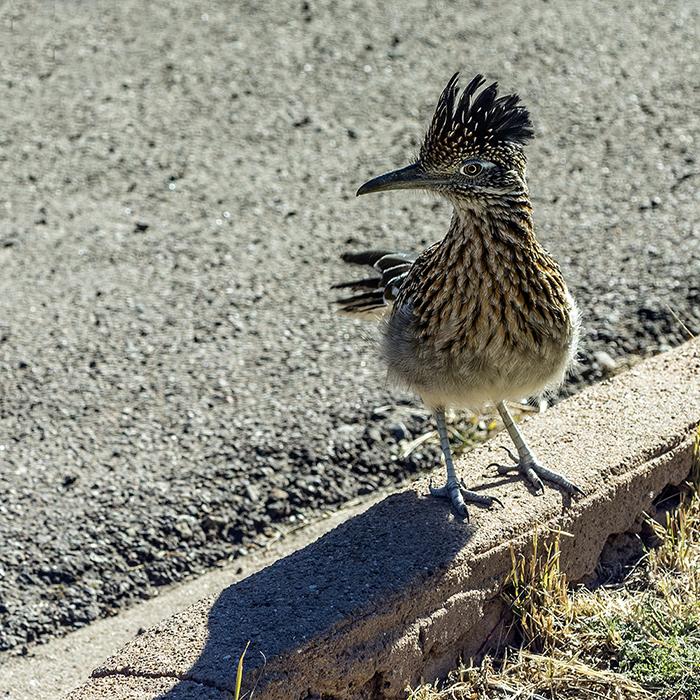
Resident Road Runner At The Chisos Mountains Lodge, Big Bend National Park / Rebecca Latson
Many photographers might find this a “boring” sort of setting with no clouds available to provide a little drama. I disagree. It’s not so much boring in this park as it is quiet, during the winter. Away from other people and cars, all that’s heard is the sound of silence. Out in the Chihuahuan Desert portion of the park, you can’t even hear the wind. Even at night, there is no sound of crickets or any other insect or nocturnal creature. Big Bend National Park is holding its breath, waiting for the greens of spring.
Within this “sound of silence”, you can capture some really nice images of the park in winter, both wide-angle and macro. Things that may be hidden from sight during the spring and summer are laid bare for your camera to see. All you need to do is be observant. And carry with you a circular polarizer and graduated neutral density (grad ND) filter.
For instance, you might glance disinterestedly at a weather-worn clump of prickly pear cactus. Instead of ignoring it, though, why not walk on over and closely inspect it. Observe the length of the needles on this cactus. Bring out your macro lens or affix a close-up filter and then capture that prickly sharpness.

Eagle Claw Cactus, Big Bend National Park / Rebecca Latson

Prickly Pear Cactus Needles, Big Bend National Park / Rebecca Latson
As you drive along the road, catch sight of all the bird nests in the cactus and leafless scrub trees along the way. Note the different sizes, from large and messily-built to small, perfectly-shaped cups of twigs and string and other building materials so cleverly used by their winged architects. It’s all there for you and your camera to see.
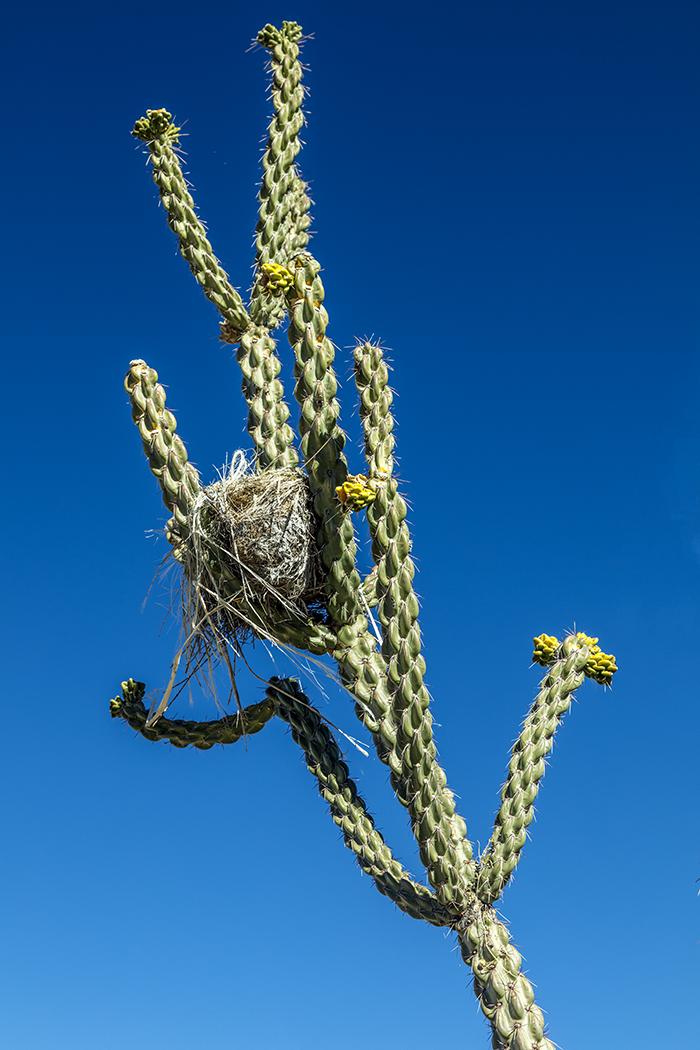
Bird's Nest and Cholla Cactus, Big Bend National Park/Rebecca Latson
The fossil exhibit stop is the perfect location to capture the wide open winter desolation of this national park. It’s also a great place for night sky and sunrise photography. During the wee hours of the morning, just prior to sunrise, park your car at the far end of the parking lot, place a handwarmer in each pocket, then set up your tripod and camera to capture the hill to your right and the far mountains and desert to your center and left as the stars begin to fade and the strip of orange/yellow sunlight peeks above the horizon. Shortly after sunrise, but before the sun climbs too high above the mountains, take your camera and tripod and walk the path from the parking lot up to the hill for a 360-degree view of everything. Catch the shadows and morning colors and bits of light on the low shrubs as the sun begins its ascent above the horizon. The best time to get great light and colors are just after the sun rises (during my stay in mid-January, it was usually around 7:45am; check your sunrise chart on your smartphone as you can still get cell service in this spot). Use your graduated ND filter to even out the bright sky and keep from under-exposing the foreground; you want shadows, yes, but not total darkness.
As the sun continues to rise, pull out your circular polarizing filter and attach it to your lens. The polarizer will make blue skies bluer, add clarity to white clouds, saturate colors, and reduce glare (as long as you are not pointing your camera directly into the sun, that is).
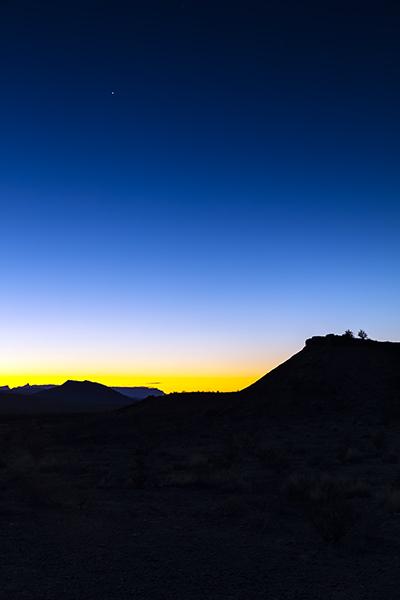
The Beginning Of Sunrise At The Fossil Exhibit Stop, Big Bend National Park / Rebecca Latson

Sunrise Over The Expanse At The Fossil Exhibit, Big Bend National Park / Rebecca Latson

Winter Sun And Ocotillo Plant, Big Bend National Park / Rebecca Latson

Empty Pods On The Yucca Plant, Big Bend National Park / Rebecca Latson
Continue driving into the Chisos Mountains (green despite the season) for some hot coffee or a full breakfast at the Chisos Mountains Lodge restaurant. Along the way, stop at the various pullouts and view areas to capture morning light on both the mountains as well as the desert around you. Usually around 10am is when the light starts to flatten out. When that happens, you can still catch (and capture) something interesting if you play around with your lenses and apertures. For example, if you are a fan of sunstars (some people like them, others do not), then set your aperture to f22, or use a really wide-angle lens (anywhere from 11mm to 24mm) and set your aperture anywhere from f11 – f22. Point your lens toward or to the side of the sun and push the shutter button. Be aware: even if you are using a lens hood, you may still acquire lens flare. It’s an acquired taste and sometimes adds interest to an image. Have fun playing around with camera, lens and settings.

A Chisos Mountains Morning, Big Bend National Park / Rebecca Latson

A Sotol "Forest", Big Bend National Park / Rebecca Latson

Chisos Mountains Vista, Big Bend National Park / Rebecca Latson
Like every other national park, Big Bend National Park affords photo opportunities all along the road and on the trail – even in winter. Desolate, yes, but also fascinating in its starkness, affording a different view from that of any other season.

Enjoying A Winter View Of The Window, Big Bend National Park / Rebecca Latson

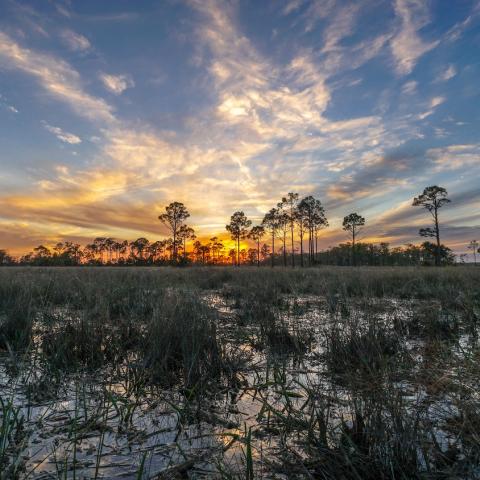

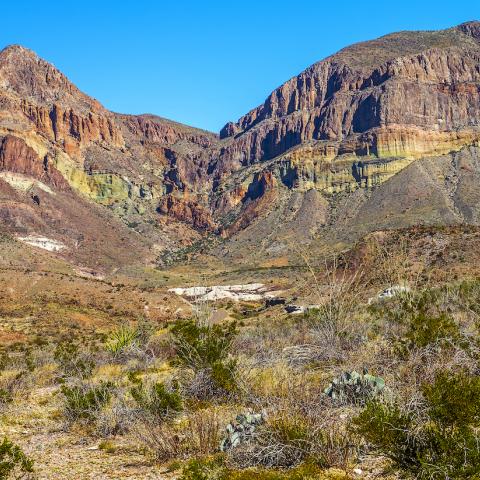
 Support Essential Coverage of Essential Places
Support Essential Coverage of Essential Places







Comments
I've spent many, many days at BBNP - in all seasons. I've been in snow in the Chisos, 110 degree temps in the desert and 'bout everything in between. One morning I woke to 20 degrees and then suffered 90 degrees plus that afternoon! I love it there!
Your pictures made Big Bend a listing on my retirement "Must See" Bucket List. Thanks!
Bruce, you are most welcome. Big Bend is indeed an amazing place and you definitely need to visit.
Thanks for another nice article and photographs. It is indeed a long drive through nowhere but it's worth the trip. Left Chiso Basin Lodge at dawn after Thanksgiving weekend and drove to the Rio Grand stopping at overlooks and short hikes and did not see another soul for 4 hours until I returned from the Santa Elena Canyon Trail. Talk about peaceful and quiet! Did see quite a few collared Peccary and Mule Deer near the north entrance both in and out. Also the 5 mile hike to the Windows and back alone was peaceful until I saw fresh urine on the walkway. Never saw a mountain lion but they are probably out there lurking around.